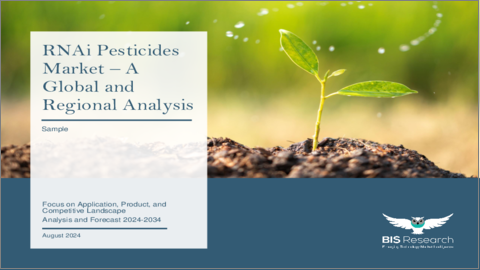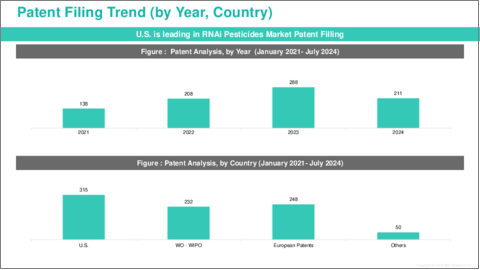|
|
市場調査レポート
商品コード
1548835
RNAi農薬市場- 世界および地域別分析:用途別、製品別、競合情勢 - 分析と予測(2024年~2034年)RNAi Pesticides Market - A Global and Regional Analysis: Focus on Application, Product, and Competitive Landscape - Analysis and Forecast, 2024-2034 |
||||||
カスタマイズ可能
|
|||||||
| RNAi農薬市場- 世界および地域別分析:用途別、製品別、競合情勢 - 分析と予測(2024年~2034年) |
|
出版日: 2024年09月05日
発行: BIS Research
ページ情報: 英文 105 Pages
納期: 1~5営業日
|
全表示
- 概要
- 目次
RNAi農薬の市場規模は、RNA干渉技術を利用した革新的な害虫駆除ソリューションに焦点を当て、より広範な農業産業の中で急速に発展している分野です。
有利なシナリオでは、2024年の市場規模は12億米ドルで、CAGR 15.7%で堅調に拡大し、2034年には約51億6,000万米ドルに達すると予測されています。
RNAi農薬は、害虫の遺伝的プロセスを特異的に阻害することで、害虫駆除に的を絞ったアプローチを提供します。この技術は、農業部門がより持続可能で環境に優しい実践に向かうにつれ、ますます重要になっています。RNAi農薬の採用は、増大する農薬耐性問題に対処する能力と、非標的生物への害を最小限に抑える可能性によって推進されています。
| 主要市場統計 | |
|---|---|
| 予測期間 | 2024年~2034年 |
| 2024年の評価額 | 12億米ドル |
| 2034年の予測 | 51億6,000万米ドル |
| CAGR | 15.7% |
農業が高度化するにつれて、RNAi農薬の需要が高まっています。現代の農法では、持続可能な食糧生産に対する規制基準や消費者の期待に応えつつ、害虫の個体数を管理するための高度なソリューションがますます求められています。RNAi農薬は、世界の持続可能性の目標に沿った効果的な防除方法を提供することで、こうしたニーズに応える態勢を整えています。
RNAi農薬市場は、作物の種類、害虫の対象、適用方法、地域によって区分されます。主な作物セグメントには、穀物・穀類、果物・野菜、特殊作物が含まれます。この技術の多用途性は、昆虫や線虫を含む様々な害虫を正確に標的にすることを可能にし、幅広い農業用途への魅力を高めています。
GreenLight Biosciences、Syngenta、Bayer、Cortevaなどの主要企業は、高度な技術と戦略的提携を活用してRNAi農薬市場の拡大を主導しています。これらの企業は、持続可能な害虫管理ソリューションに対する需要の増加に対応するため、技術革新と生産能力の拡大に注力しています。
農業業界がより持続可能で効果的な害虫駆除のために革新的な技術を取り入れ続けていることから、RNAi農薬市場は大幅な成長を遂げると思われます。RNAi技術の継続的な進歩と現代農法への統合は、この市場が害虫管理戦略を世界的に変革する可能性を強調しています。
当レポートでは、世界のRNAi農薬市場について調査し、市場の概要とともに、用途別、製品別、地域別の動向、および市場に参入する企業のプロファイルなどを提供しています。
目次
エグゼクティブサマリー
第1章 市場:業界の展望
- 動向:現在および将来の影響評価
- サプライチェーンの概要
- R&Dレビュー
- 規制状況
- ステークホルダー分析
- 市場力学の概要
- スタートアップ資金調達の概要
第2章 RNAi農薬市場(用途別)
- 用途の概要
- RNAi農薬市場、用途別、金額、数量、2023年~2034年
- RNAi農薬市場、作物タイプ別、金額、数量、2023年~2034年
第3章 RNAi農薬市場(製品別)
- 製品概要
- RNAi農薬市場、製品別、金額、数量、2023年~2034年
- RNAi農薬市場、剤形別、金額、数量、2023年~2034年
第4章 RNAi農薬市場(地域別)
- RNAi農薬市場- 地域別
- 北米
- 欧州
- アジア太平洋
- その他の地域
第5章 市場-競合ベンチマーキングと企業プロファイル
- 今後の見通し
- 地域分析
- 競合ベンチマーキング
- 企業プロファイル
- Syngenta
- GreenLight Biosciences, Inc
- TRILLIUM AG
- Innatrix, Inc
- RNAiSSANE AG
- Pebble Labs
- AgroSpheres
- Vestaron Corporation
- Elemental Enzymes, Inc
- SOLASTA Bio
- MICROPEP
- Invaio Sciences
- Genvor Incorporated
- Corteva
- Bayer AG
第6章 調査手法
Introduction to RNAi Pesticides Market
The RNAi Pesticides Market is a rapidly evolving segment within the broader agricultural industry, focusing on innovative pest control solutions that utilize RNA interference technology. In a favorable scenario, the market is valued at $1.20 billion in 2024 and is projected to expand at a robust CAGR of 15.7% to reach approximately $5.16 billion by 2034.
RNAi pesticides offer a targeted approach to pest control by specifically interfering with the genetic processes of pests, thereby reducing the need for broad-spectrum chemical pesticides. This technology is increasingly important as the agricultural sector moves towards more sustainable and environmentally friendly practices. The adoption of RNAi pesticides is driven by their ability to address the growing issue of pesticide resistance and their potential to minimize harm to non-target organisms.
| KEY MARKET STATISTICS | |
|---|---|
| Forecast Period | 2024 - 2034 |
| 2024 Evaluation | $1.20 Billion |
| 2034 Forecast | $5.16 Billion |
| CAGR | 15.7% |
As agriculture becomes more sophisticated, the demand for RNAi pesticides is growing. Modern farming practices increasingly require advanced solutions to manage pest populations while meeting regulatory standards and consumer expectations for sustainable food production. RNAi pesticides are poised to meet these needs by providing effective control methods that align with global sustainability goals.
The RNAi pesticides market is segmented based on crop types, pest targets, application methods, and regions. Key crop segments include cereals and grains, fruits and vegetables, and specialty crops. The technology's versatility allows for precise targeting of various pests, including insects and nematodes, enhancing its appeal to a broad range of agricultural applications.
Regional dynamics shape the RNAi pesticides market significantly. North America leads due to its advanced agricultural technology and supportive regulations. The United States and Canada are pivotal in North America's RNAi pesticides market. The U.S. leads with its advanced agricultural technology and strong research initiatives. Canada recently made headlines on June 14, 2023, when its Pest Management Research Agency (PMRA) approved an RNAi biopesticide by Renaissance Bioscience Corp. This development signifies a move towards more targeted and eco-friendly pest control solutions, further boosting market growth in the region. Europe and Asia-Pacific also play important roles. Europe has a strong agricultural sector and is focusing more on sustainable solutions. Asia-Pacific is growing its interest in advanced pest control technologies. Both regions are adopting RNAi pesticides to manage pests effectively while meeting environmental standards.
Key players such as GreenLight Biosciences, Syngenta, Bayer, and Corteva are leading the expansion of the RNAi pesticides market by leveraging their advanced technology and strategic collaborations. These companies are focusing on innovation and scaling up their production capabilities to meet the increasing demand for sustainable pest management solutions. A notable development occurred in January 2024 when GreenLight Biosciences received U.S. EPA registration for its RNAi-based bioinsecticide, Calantha, which targets the Colorado potato beetle. This advancement highlights a significant leap in sustainable agriculture, providing farmers with an effective alternative to conventional pesticides and tackling the issue of chemical resistance.
The RNAi pesticides market is set for substantial growth as the agricultural industry continues to embrace innovative technologies for more sustainable and effective pest control. The ongoing advancements in RNAi technology and its integration into modern farming practices underscore the market's potential to transform pest management strategies globally.
Market Segmentation:
Segmentation 1: by Application
- Insect Pest Control
- Weed Management
- Disease Management
- Resistance Management
Segmentation 2: by Crop Type
- Agricultural Application
- Fruits and Vegetables
- Cereals and Grains
- Oilseed and Pulses
- Others
- Non-Agricultural Application
- Turf and Ornamentals
- Forestry
- Residential Pest Control
Segmentation 3: by Product
- Tropical RNAi Pesticide
- Seed Embedded RANi
- Transgenic RNAi
- Others
Segmentation 4: by Formulation
- Liquid Formulation
- Granular Formulation
- Powder Formulation
- Others
Segmentation 5: by Region
- North America
- Europe
- Asia-Pacific
- Rest-of-the-World
How can this report add value to an organization?
Product/Innovation Strategy: The global RNAi pesticides market has been extensively segmented based on various categories, such as application, crop type, product, and formulation. This can help readers get a clear overview of which segments account for the largest share and which ones are well-positioned to grow in the coming years.
Competitive Strategy: A detailed competitive benchmarking of the players operating in the global RNAi pesticides market has been done to help the reader understand how players stack against each other, presenting a clear market landscape. Additionally, comprehensive competitive strategies such as partnerships, agreements, and collaborations will aid the reader in understanding the untapped revenue pockets in the market.
Key Market Players and Competition Synopsis
The companies that are profiled have been selected based on thorough secondary research, which includes analyzing company coverage, product portfolio, market penetration, and insights gathered from primary experts.
Some of the prominent companies in this market are:
- Syngenta
- GreenLight Biosciences, Inc
- TRILLIUM AG
- Pebble Labs
- AgroSpheres
- Vestaron Corporation
- Elemental Enzymes, Inc
Key Questions Answered in this Report:
- What are the main factors driving the demand for RNAi pesticides in the market?
- What are the major patents filed by companies active in the RNAi pesticides market?
- Who are the key players in the RNAi pesticides market, and what are their respective market shares?
- What partnerships or collaborations are prominent among stakeholders in the RNAi pesticides market?
- What strategies are adopted by key companies to gain a competitive edge in the RNAi pesticides market?
- What is the futuristic outlook for the RNAi pesticides market in terms of growth potential?
- What is the current estimation of the RNAi pesticides market, and what growth trajectory is projected from 2024 to 2034?
- Which application and product segments are expected to lead the RNAi pesticides market over the forecast period (2024-2034)?
- Which regions demonstrate the highest adoption rates for RNAi pesticides, and what factors contribute to their leadership?
Table of Contents
Executive Summary
Scope and Definition
Market/Product Definition
Key Questions Answered
Analysis and Forecast Note
1. Markets: Industry Outlook
- 1.1 Trends: Current and Future Impact Assessment
- 1.1.1 Increased Adoption of Integrated Pest Management
- 1.1.2 Rising Investment in Research and Development
- 1.2 Supply Chain Overview
- 1.2.1 Value Chain Analysis
- 1.2.2 Pricing Forecast
- 1.3 R&D Review
- 1.3.1 Patent Filing Trend by Country, by Company
- 1.4 Regulatory Landscape
- 1.5 Stakeholder Analysis
- 1.6 Market Dynamics Overview
- 1.6.1 Market Drivers
- 1.6.2 Market Restraints
- 1.6.3 Market Opportunities
- 1.7 Startup Funding Summary
2. RNAi Pesticides Market by Application
- 2.1 Application Summary
- 2.2 RNAi Pesticides Market, by Application,Value and Volume, 2023-2034
- 2.2.1 Insect Pest Control
- 2.2.2 Weed Management
- 2.2.3 Disease Management
- 2.2.4 Resistance Management
- 2.3 RNAi Pesticides Market, by Crop Type, Value and Volume, 2023-2034
- 2.3.1 Agricultural Application
- 2.3.1.1 Fruits and Vegetables
- 2.3.1.2 Cereals and Grains
- 2.3.1.3 Oilseed and Pulses
- 2.3.1.4 Others
- 2.3.2 Non-Agricultural Application
- 2.3.2.1 Turf and Ornamentals
- 2.3.2.2 Forestry
- 2.3.2.3 Residential Pest Control
- 2.3.1 Agricultural Application
3. RNAi Pesticides Market by Products
- 3.1 Product Summary
- 3.2 RNAi Pesticides Market, by Product, Value and Volume, 2023-2034
- 3.2.1 Topical RNAi Pesticides
- 3.2.2 Seed-Embedded RNAi
- 3.2.3 Transgenic RNAi
- 3.2.4 Others
- 3.3 RNAi Pesticides Market, by Formulation, Value and Volume, 2023-2034
- 3.3.1 Liquid Formulation
- 3.3.2 Granular Formulation
- 3.3.3 Powder Formulation
- 3.3.4 Others
4. RNAi Pesticides Market by Region
- 4.1 RNAi Pesticides Market - by Region
- 4.2 North America
- 4.2.1 Regional Overview
- 4.2.1.1 Driving Factors for Market Growth
- 4.2.1.2 Factors Challenging the Market
- 4.2.2 Application
- 4.2.3 Product
- 4.2.4 North America (by Country)
- 4.2.4.1 U.S.
- 4.2.4.1.1 Market by Application
- 4.2.4.1.2 Market by Product
- 4.2.4.2 Canada
- 4.2.4.2.1 Market by Application
- 4.2.4.2.2 Market by Product
- 4.2.4.3 Mexico
- 4.2.4.3.1 Market by Application
- 4.2.4.3.2 Market by Product
- 4.2.4.1 U.S.
- 4.2.1 Regional Overview
- 4.3 Europe
- 4.3.1 Regional Overview
- 4.3.1.1 Driving Factors for Market Growth
- 4.3.1.2 Factors Challenging the Market
- 4.3.2 Application
- 4.3.3 Product
- 4.3.4 Europe (by Country)
- 4.3.4.1 Germany
- 4.3.4.1.1 Market by Application
- 4.3.4.1.2 Market by Product
- 4.3.4.2 France
- 4.3.4.2.1 Market by Application
- 4.3.4.2.2 Market by Product
- 4.3.4.3 U.K
- 4.3.4.3.1 Market by Application
- 4.3.4.3.2 Market by Product
- 4.3.4.4 Italy
- 4.3.4.4.1 Market by Application
- 4.3.4.4.2 Market by Product
- 4.3.4.5 Rest-of-Europe
- 4.3.4.5.1 Market by Application
- 4.3.4.5.2 Market by Product
- 4.3.4.1 Germany
- 4.3.1 Regional Overview
- 4.4 Asia-Pacific
- 4.4.1 Regional Overview
- 4.4.1.1 Driving Factors for Market Growth
- 4.4.1.2 Factors Challenging the Market
- 4.4.2 Application
- 4.4.3 Product
- 4.4.4 Asia-Pacific (by Country)
- 4.4.4.1 China
- 4.4.4.1.1 Market by Application
- 4.4.4.1.2 Market by Product
- 4.4.4.2 Japan
- 4.4.4.2.1 Market by Application
- 4.4.4.2.2 Market by Product
- 4.4.4.3 Australia
- 4.4.4.3.1 Market by Application
- 4.4.4.3.2 Market by Product
- 4.4.4.4 South Korea
- 4.4.4.4.1 Market by Application
- 4.4.4.4.2 Market by Product
- 4.4.4.5 Rest-of-Asia-Pacific
- 4.4.4.5.1 Market by Application
- 4.4.4.5.2 Market by Product
- 4.4.4.1 China
- 4.4.1 Regional Overview
- 4.5 Rest-of-the-World
- 4.5.1 Regional Overview
- 4.5.1.1 Driving Factors for Market Growth
- 4.5.1.2 Factors Challenging the Market
- 4.5.2 Application
- 4.5.3 Product
- 4.5.4 Rest-of-the-World (by Region)
- 4.5.4.1 South America
- 4.5.4.1.1 Market by Application
- 4.5.4.1.2 Market by Product
- 4.5.4.2 Middle East and Africa
- 4.5.4.2.1 Market by Application
- 4.5.4.2.2 Market by Product
- 4.5.4.1 South America
- 4.5.1 Regional Overview
5. Markets- Competitive Benchmarking and Companies Profiled
- 5.1 Next Frontier
- 5.2 Geographical Analysis
- 5.3 Competitive Benchmarking
- 5.4 Company Profiles
- 5.4.1 Syngenta
- 5.4.1.1 Overview
- 5.4.1.2 Top Products / Product Portfolio
- 5.4.1.3 Top Competitors
- 5.4.1.4 Target Customers/End-Users
- 5.4.1.5 Key Personnel
- 5.4.1.6 Analyst View
- 5.4.1.7 Market Share
- 5.4.2 GreenLight Biosciences, Inc
- 5.4.2.1 Overview
- 5.4.2.2 Top Products / Product Portfolio
- 5.4.2.3 Top Competitors
- 5.4.2.4 Target Customers/End-Users
- 5.4.2.5 Key Personnel
- 5.4.2.6 Analyst View
- 5.4.2.7 Market Share
- 5.4.3 TRILLIUM AG
- 5.4.3.1 Overview
- 5.4.3.2 Top Products / Product Portfolio
- 5.4.3.3 Top Competitors
- 5.4.3.4 Target Customers/End-Users
- 5.4.3.5 Key Personnel
- 5.4.3.6 Analyst View
- 5.4.3.7 Market Share
- 5.4.4 Innatrix, Inc
- 5.4.4.1 Overview
- 5.4.4.2 Top Products / Product Portfolio
- 5.4.4.3 Top Competitors
- 5.4.4.4 Target Customers/End-Users
- 5.4.4.5 Key Personnel
- 5.4.4.6 Analyst View
- 5.4.4.7 Market Share
- 5.4.5 RNAiSSANE AG
- 5.4.5.1 Overview
- 5.4.5.2 Top Products / Product Portfolio
- 5.4.5.3 Top Competitors
- 5.4.5.4 Target Customers/End-Users
- 5.4.5.5 Key Personnel
- 5.4.5.6 Analyst View
- 5.4.5.7 Market Share
- 5.4.6 Pebble Labs
- 5.4.6.1 Overview
- 5.4.6.2 Top Products / Product Portfolio
- 5.4.6.3 Top Competitors
- 5.4.6.4 Target Customers/End-Users
- 5.4.6.5 Key Personnel
- 5.4.6.6 Analyst View
- 5.4.6.7 Market Share
- 5.4.7 AgroSpheres
- 5.4.7.1 Overview
- 5.4.7.2 Top Products / Product Portfolio
- 5.4.7.3 Top Competitors
- 5.4.7.4 Target Customers/End-Users
- 5.4.7.5 Key Personnel
- 5.4.7.6 Analyst View
- 5.4.7.7 Market Share
- 5.4.8 Vestaron Corporation
- 5.4.8.1 Overview
- 5.4.8.2 Top Products / Product Portfolio
- 5.4.8.3 Top Competitors
- 5.4.8.4 Target Customers/End-Users
- 5.4.8.5 Key Personnel
- 5.4.8.6 Analyst View
- 5.4.8.7 Market Share
- 5.4.9 Elemental Enzymes, Inc
- 5.4.9.1 Overview
- 5.4.9.2 Top Products / Product Portfolio
- 5.4.9.3 Top Competitors
- 5.4.9.4 Target Customers/End-Users
- 5.4.9.5 Key Personnel
- 5.4.9.6 Analyst View
- 5.4.9.7 Market Share
- 5.4.10 SOLASTA Bio
- 5.4.10.1 Overview
- 5.4.10.2 Top Products / Product Portfolio
- 5.4.10.3 Top Competitors
- 5.4.10.4 Target Customers/End-Users
- 5.4.10.5 Key Personnel
- 5.4.10.6 Analyst View
- 5.4.10.7 Market Share
- 5.4.11 MICROPEP
- 5.4.11.1 Overview
- 5.4.11.2 Top Products / Product Portfolio
- 5.4.11.3 Top Competitors
- 5.4.11.4 Target Customers/End-Users
- 5.4.11.5 Key Personnel
- 5.4.11.6 Analyst View
- 5.4.11.7 Market Share
- 5.4.12 Invaio Sciences
- 5.4.12.1 Overview
- 5.4.12.2 Top Products / Product Portfolio
- 5.4.12.3 Top Competitors
- 5.4.12.4 Target Customers/End-Users
- 5.4.12.5 Key Personnel
- 5.4.12.6 Analyst View
- 5.4.12.7 Market Share
- 5.4.13 Genvor Incorporated
- 5.4.13.1 Overview
- 5.4.13.2 Top Products / Product Portfolio
- 5.4.13.3 Top Competitors
- 5.4.13.4 Target Customers/End-Users
- 5.4.13.5 Key Personnel
- 5.4.13.6 Analyst View
- 5.4.13.7 Market Share
- 5.4.14 Corteva
- 5.4.14.1 Overview
- 5.4.14.2 Top Products / Product Portfolio
- 5.4.14.3 Top Competitors
- 5.4.14.4 Target Customers/End-Users
- 5.4.14.5 Key Personnel
- 5.4.14.6 Analyst View
- 5.4.14.7 Market Share
- 5.4.15 Bayer AG
- 5.4.15.1 Overview
- 5.4.15.2 Top Products / Product Portfolio
- 5.4.15.3 Top Competitors
- 5.4.15.4 Target Customers/End-Users
- 5.4.15.5 Key Personnel
- 5.4.15.6 Analyst View
- 5.4.15.7 Market Share
- 5.4.1 Syngenta






